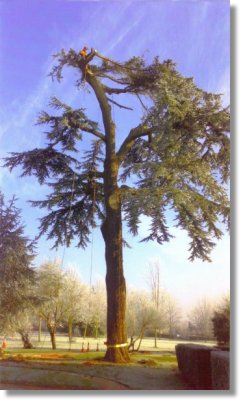
tree care stratford upon avon
tree care stratford upon avon
tree care stratford upon avon surgery, arborist, stratford upon avon, warwickshire, worcestershire, cotswolds, arboriculture, work, insured, professional, specialist, pruning, felling, care, hedge, thinning, lifting, stump, quote
Arboriculture, is the cultivation, management, and study of individual trees, shrubs, vines, and other perennial woody plants. It is both a practice and a science.
The science of arboriculture studies how these plants grow and respond to cultural practices and to their environment. The practice of arboriculture includes cultural techniques such as selection, planting, training, fertilization, pest and pathogen control, pruning, shaping, and removal.
Risk management, legal issues, and aesthetic considerations have come to play prominent roles in the practice of arboriculture.
Arboriculture is primarily focused on individual woody plants and trees maintained for permanent landscape and amenity purposes, usually in gardens, parks or other populated settings, by arborists, for the enjoyment, protection, and benefit of human beings. It is therefore related to, but distinct from agriculture, horticulture, urban forestry, forestry, dendrology, and silviculture.
An arborist, or (less commonly) arboriculturalist, is a professional in the practice of arboriculture, which is the cultivation, management, and study of individual trees, shrubs, vines, and other perennial woody plants. Arborists generally focus on the health and safety of individual plants and trees, rather than managing forests (the domains of Forestry and Silviculture) or harvesting wood. An arborist's scope of work is therefore distinct from that of either a forester or a logger, though the professions share much in common.
To work near power wires either additional training is required for arborists or they need to be Certified Line Clearance trimmers or Utility Arborists (there may be different terminology for various countries). There is a variety of minimum distances that must be kept from power wires depending on voltage, however the common distance for low voltage lines in urban settings is 10 feet (about 3 metres).
Arborists who climb (as not all do) can use a variety of techniques to ascend into the tree. The least invasive, and most popular technique used is to ascend on rope. When personal safety is an issue, or the tree is being removed, arborists may use 'hooks', (also known as 'gaffs' or 'spurs') attached to their boots with straps to ascend and work. Hooks wound the tree, leaving small holes where each step has been.
An arborist's work may involve very large and complex trees, or ecological communities and their abiotic components in the context of the landscape ecosystem. These may require monitoring and treatment to ensure they are healthy, safe, and suitable to property owners or community standards. This work may include some or all of the following: planting; transplanting; pruning; structural support; preventing, or diagnosing and treating phytopathology or parasitism; preventing or interrupting grazing or predation; installing lightning protection; and removing vegetation deemed as hazardous, an invasive species, a disease vector, or a weed.
Arborists may also plan, consult, write reports and give legal testimony. While some aspects of this work are done on the ground or in an office, much of it is done by arborists who climb the trees with ropes, harnesses and other equipment. Lifts and cranes may be used too. The work of all arborists is not the same. Some may just perform consulting; others may perform climbing, pruning and planting: a combination.
Arborists gain qualifications to practice arboriculture in a variety of ways and some arborists are more qualified than others. Experience working safely and effectively in and around trees is essential. Arborists tend to specialize in one or more disciplines of arboriculture, such as diagnosis and treatment, climbing and pruning, cabling and lightning protection, or perhaps consultation and report writing. All these disciplines are related and some arborists are very well experienced in all areas of tree work, but not all arborists have the training or experience to properly practice every discipline.
Many arborists choose to pursue formal certification, which is available in some countries and varies somewhat by location. An arborist who holds certification in one or more disciplines may be expected to participate in rigorous continuing education requirements to ensure continuous improvement of skills and techniques.
In Australia arboricultural education and training are streamlined countrywide through a multi-disciplinary vocational education, training, and qualification authority called the Australian Qualifications Framework, which offers varying levels of professional qualification.
In France a qualified arborist must hold a Management of Ornamental Trees certificate, and a qualified arborist climber must hold a Pruning and Care of Trees certificate; both delivered by the French Ministry of Agriculture.
In the UK an arborist can gain qualifications up to and including a Masters degree. Generally most arborists only attain chainsaw related safety certificates (NPTCs) and do not progress to higher academic study. Most agricultural colleges offer national certificates, diplomas and some offer foundation, bachelor and masters degrees in arboriculture.